Orange Is The New Black: Shetty managed to trade robes for refinement without losing his sense of self. Image: Michael Schwartz, Styling: Mark Holmes.
Former monk-turned superstar author, podcaster, life coach, management guru and digital influencer, Jay Shetty, reveals how he’s been able to apply the wisdom and tools gleaned from three years spent in an Indian ashram to the challenges of modern life. Discover how a monk mindset could help you reach your personal nirvana.
I hear Jay Shetty before I see him.
“Hey Ben,” he shouts from my blank screen before bursting into picture on our Zoom call. He begins by apologising profusely for being a little late.
“I don’t like keeping anyone waiting,” he tells me, his astonishingly green eyes illuminated by the afternoon sun pouring through the window of his hotel room in Santa Barbara, where he’s taken his team on a company retreat.
To be honest, you expect a certain level of solicitousness from a former monk, if not, perhaps, from a global superstar. Particularly one who’s become the spiritual guru of choice for celebs like Will Smith and Jennifer Lopez, who wrote a New-York Times best-selling book, Think Like A Monk, hosts the world’s number one health and wellness podcast, On Purpose, is the chief purpose officer for the meditation and relaxation app, Calm, and has over 50 million followers across his various social media channels.
The somewhat jarring dichotomy of who Shetty once was and who he is now and the ways in which he’s managed to straddle the yawning chasm between a life defined by asceticism and service and one that’s earned him significant fame and fortune, is what makes him such an intriguing figure.
He was, perhaps, meant for both lives. Dressed in a light blue shirt with a white Tee that doesn’t quite hide a tattoo creeping up his neck, Shetty’s green eyes and neatly trimmed beard lend him a mystical aura befitting one who might devote themselves to a life of sacrifice, service and, frequently, silence. Those same mesmerising eyes have also proved perfect instruments to beam out of screens and phones on YouTube, Facebook and Instagram, where he’s passionate and persuasive in articulating the benefits of a monk mindset to regular Joes and Jennies.
Shetty acknowledges the paradox of his past and present and the inevitable and inherent contradictions in trying to take the tenets of ancient spirituality to the masses through digital devices. He’s in a constant battle, he says, to body-slam his ego and strive for humility, even as his sales and clicks keep racking up. Yet Shetty doesn’t try or feel the need to reconcile these contradictions.
“I truly believe that if we seek inner awareness, each and every single one of us is more of a paradox than we are a box,” says the 34-year-old, who grew up in North London.
“I’m a monk in my mindset. I’m in media and I love management. If I really accept all parts of myself authentically, then I want to be all of those. And I think I’m allowing myself to be a paradox because that is true to who I am, rather than hiding or putting aside a part of myself that feels like it needs to be expressed.”
Later he tells me, “You are where you need to be”, when I ask him for his favourite mantra. Shetty certainly seems to be in the right place to dispense spiritually sourced, self-help wisdom to a hungry audience: California. Yet putting cynicism aside, as you inevitably find yourself doing when you talk to Shetty, his is a remarkable story, one that seems driven by a sense of destiny yet in the moment was frequently precarious, absent of foresight or calculation.
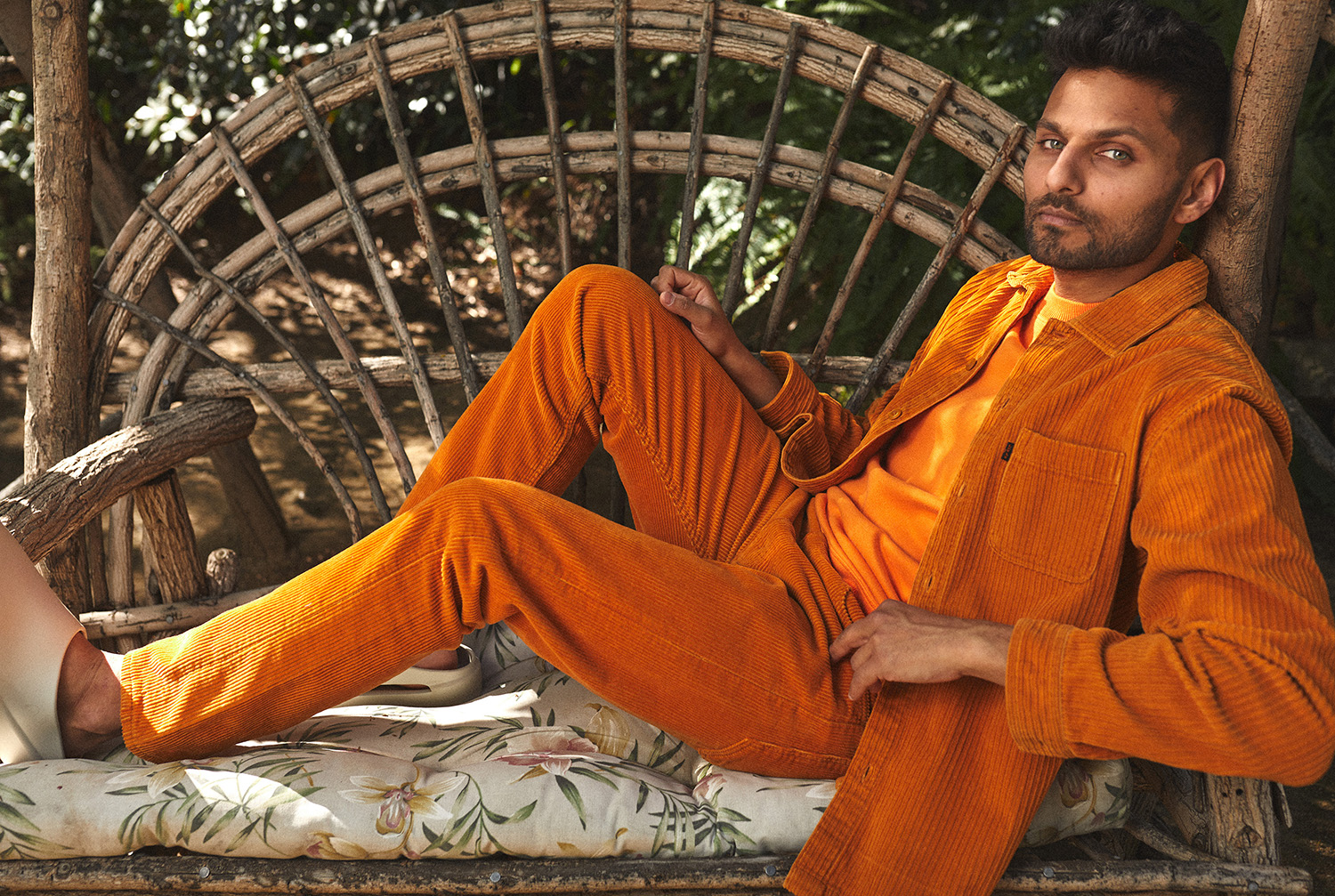
Image: Michael Schwartz, Styling: Mark Holmes.
As Shetty details in Think Like A Monk, when he was 18 and studying at university in London, a friend urged him to attend a campus talk by an Indian monk named Gauranga Das. Shetty had no interest in going, only agreeing to accompany his friend if they could go for a drink afterwards. Instead, Das’ lecture changed Shetty’s life. He began following the monk around on his lecture tour of the UK, before deciding to spend his next few summers at Das’ ashram in Mumbai, while he continued his studies. After university he turned his back on lucrative job offers to join the ashram full time.
Three years of soul-shaping service, sacrifice (you know, four-hour meditations, cold showers, simple meals etc) and spiritual enlightenment later, Shetty left the ashram armed with a toolkit he knew worked in a vacuum. He was still unsure, however, about its practical value in a world of convenience, shortcuts, hacks and hollow promises. His doubts were proved right, at least initially.
Rejected by over 40 companies, Shetty despaired that his three-year spiritual odyssey had been a waste of time, until one day, as he was washing the dishes at his parents’ home, he imagined what he’d be doing right at that moment if he were back in the ashram. The answer was meditating and praying. This led to an epiphany: maybe he could ply the wisdom and skills he’d learned in the ashram, as well as his innate gifts, to serve others, and by extension, himself, in the real world. Jobs at Accenture and later HuffPost helped launch him before he took his gift for spreading timeless truths through snappy video content to his own digital platforms. The rest is history, even if it reads like a modern parable.
With wisdom drawn from ancient texts that have long been co-opted by the self-help industry, much of Shetty’s message is familiar. What perhaps distinguishes him from other social media sages is that he’s actually lived by the tenets he espouses. He doesn’t ask you to do the same, he says. Just apply what works for you.
Here Shetty recounts the pivotal moments in his journey and reveals how he’s used his monk mindset to thrive personally and professionally. Plumber or programmer, if you’re seeking more meaning in your life, Shetty’s story and the wisdom it draws on could offer you a shot, not at enlightenment – tough if YOLO – but to embrace that most powerful, though for many of us, most confounding paradox of all: achieving personal fulfillment through serving others.
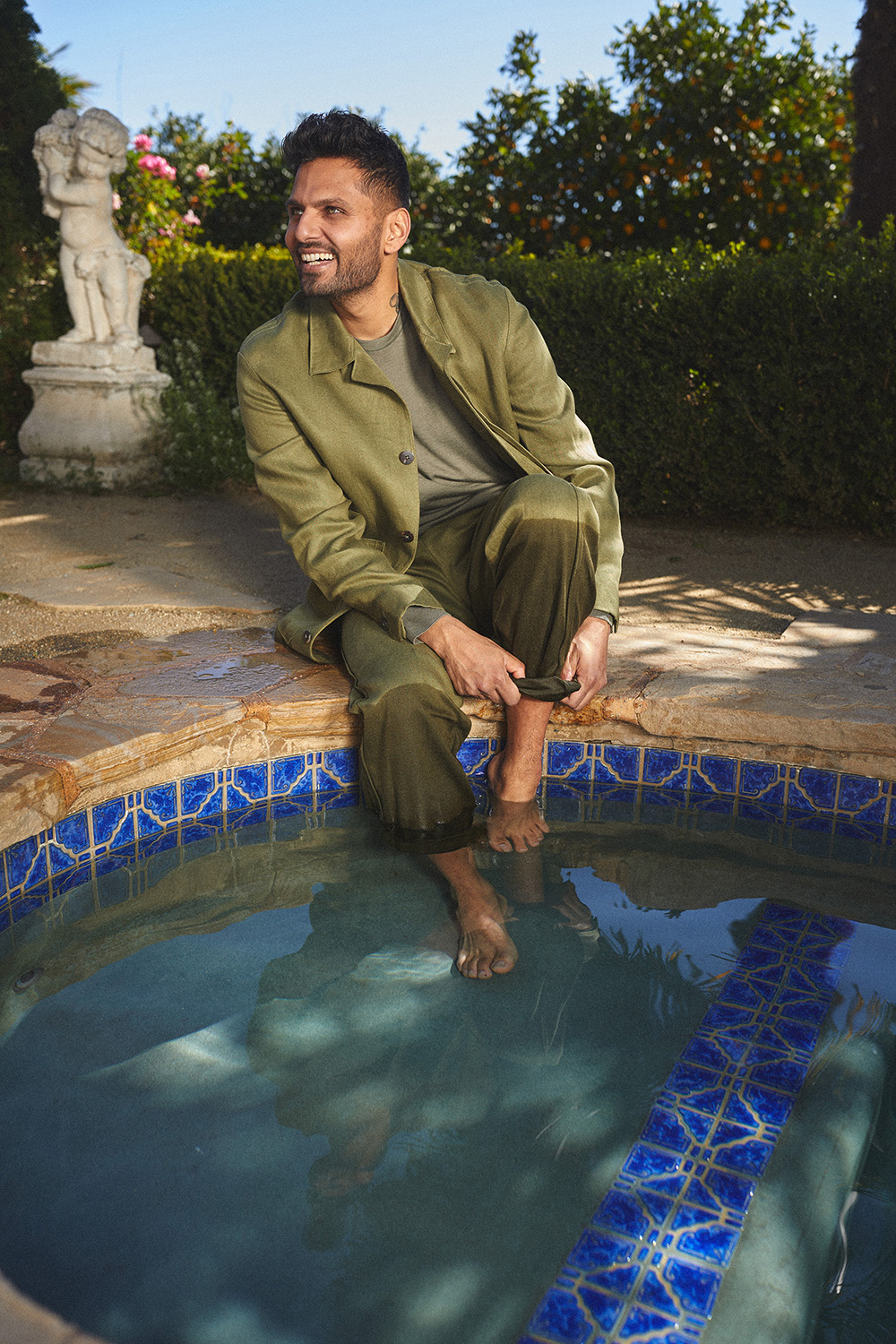
The journey to inner peace starts with self-reflection. Image: Michael Schwartz, Styling: Mark Holmes.
Men’s Health: Let’s start at the beginning. What kind of kid
were you?
Jay Shetty: I was an extremely well-behaved kid. I did my homework on time, tried to follow all the rules.
I think I was a good son, who was quite shy, very introverted, not very confident. I was bullied a lot. I was one of the few South Asian people in the area I grew up in. I was also overweight and so I was bullied for that as well. All I remember from that experience, though, is gaining a sense of compassion. Never wanting to bully anyone or make anyone feel that way, because I felt how hard it was to experience that.
Around 14, I started to become a bit more rebellious. I think I felt I’d followed all the rules and dotted all the i’s and I was still experiencing racism. It was almost like I got to a place in my life where I was like, “Well, being good doesn’t work. Because if I’m being good, but I’m still treated badly, how does that work?” It kind of became, “Well, nothing really matters”.
Before you went with your friend to listen to Gauranga Das, you were interested in CEOs, celebrities and successful people. Were you always an aspirational person?
I grew up believing I didn’t like reading because all the books at school were fiction books. So, you’d be asked to read Goosebumps or Harry Potter and I just never felt genuinely captivated. When I was around 14, my dad started
giving me biographies and autobiographies and that’s where my aspiration came from. I was just fascinated by people who’d gone through challenges and had overcome something in their life. That blew my mind.
So, I was reading about Dwayne Johnson, David Beckham, in terms of cultural people. And I was reading the biographies or the writings of Martin Luther King, Malcolm X, Einstein and then much later on, people like Steve Jobs.
I spent so much time with stories of incredible mastery. I liked the idea that there could be more to life than what I saw around me, which was do well at school, go to a good university, get a good job, marry a good person. It was attractive to me that people could live for a purpose greater than that.
“Your ego will appear every day. the difference is how quickly you spot it.”
How would you describe the Jay Shetty who went into the ashram and the one who emerged from it?
If you look at the transitions in my life, I went from being really shy and organised to then being really gutsy and almost a bit of a troublemaker, to then becoming
a monk. It was a stark contrast. But I’d say I went into the ashram with enthusiasm. I did it with commitment and with authenticity.
The version of me that left was one that still had all of that, but with so much more assurance and confidence that I had made the right decision. I’m now walking out, not with the idea of mastering the mind, but with a toolkit. I’m now not just the person who’s fascinated by timeless wisdom, I know how to apply it in my life. I’m not just the person who wants to wake up early and live with good routines, I actually have the discipline to do it. It’s almost like the muscle had been strengthened in that time from being an idea or a hope, to actually being something I could apply.
What stayed the same was this desire to serve. That’s why I went there and that desire just expanded. I was like, “Okay, I’ve discovered something phenomenal. And I’m really lucky to have that”.
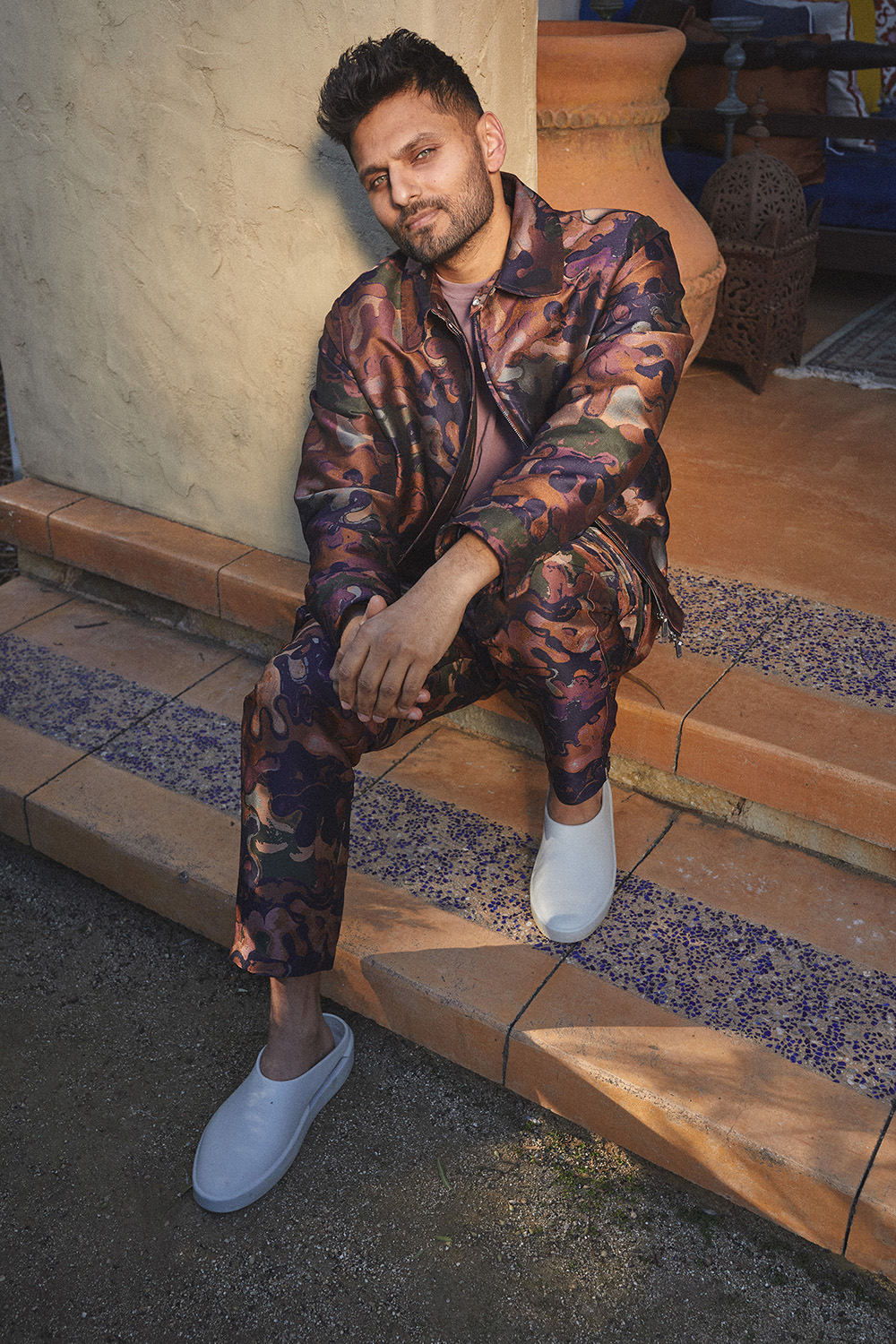
Image: Michael Schwartz, Styling: Mark Holmes.
Not many people go into an ashram with the level of commitment you did. Where do you think that came from?
JS My enthusiasm and commitment came from the fact that Gauranga Das is just such an inspiring, phenomenal individual. I’d seen that his commitment had just brought incredible fruits. I could tell how disciplined he was, how focused, how present, how attentive, how masterful he was. I was so in awe of the human being that I saw in front of me. I actually think it’s not too dissimilar from shadowing a CEO that you love or if you see an athlete you admire.
It’s like, “Who was their coach? Who did they train with?” It was almost like, “Well, it’s worked for him, so it’ll work for me”.
I also realised you can learn by watching other people’s mistakes.
I could see people around me who were chasing everything, but they weren’t fulfilled. But here was this monk not chasing anything. And he was fulfilled. He was just seeking to serve. I actually got to see how someone could be so powerful, yet so humble. I was fascinated by how you could be both. Somebody who wants to help everyone, but they’re not asking for any credit. What a phenomenal mindset! And I wanted that. I was like, “That sounds like success in life”.
You said in your book you were reluctant to leave the ashram. Why was that?
When you’re practising that much self-awareness and you’re pursuing that much inner discovery, you get really honest with yourself. And the honest answer was, “I don’t think I’m meant to be a monk forever”. And that’s scary when you’ve left everything behind to be a monk. I turned down corporate job offers. My extended family thought I was a failure by going off to become a monk. Many of my friends didn’t really understand what I was doing. I was just fearful that if I left this path, what would my life be? I would just be broken… and that wasn’t untrue when I first came back.
So, my reluctance to leave came from fear, but I had to accept the fearful path because I knew it was true. There’s a lesson in that because it was more uncomfortable for me to leave, but that discomfort was important because I was becoming more honest and truthful to who I actually was, which was someone who wanted to share the wisdom I learned from the monks but not continue to be a monk. And that honesty with yourself… it’s so brutal. To the world, it looks like you didn’t make it. You’re worried about what people will say. What will they think? But I knew I had to do it because staying would’ve been me lying to myself and lying to others.
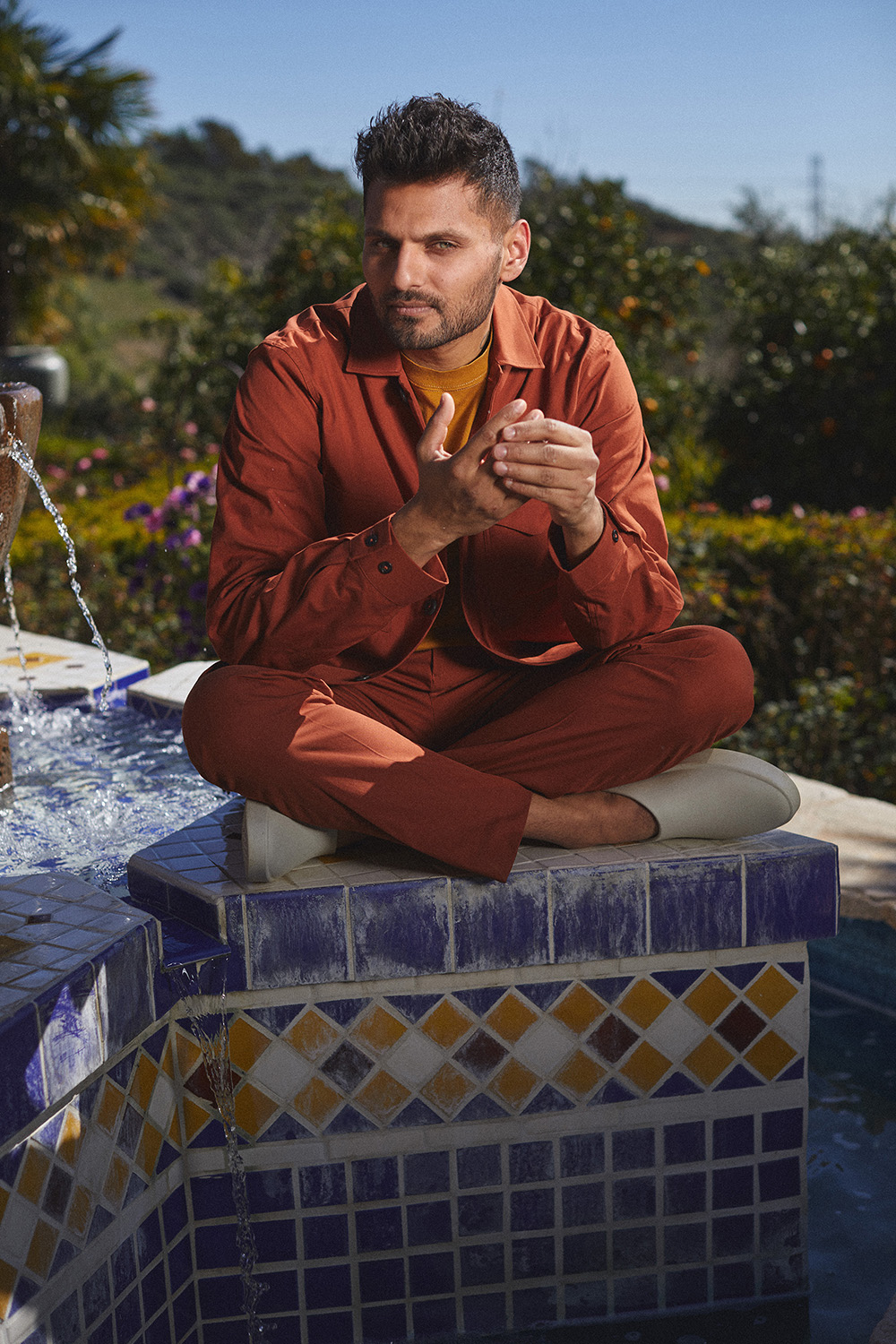
Image: Michael Schwartz, Styling: Mark Holmes.
How much doubt and insecurity did you have in that period after you left the ashram?
It was probably one of the most depressive times of my life. Because I didn’t really know where I fit in anymore. I moved back in with my parents. I had my whole student debt to pay off. I didn’t have a penny to my name. I didn’t own anything. I had to figure out where I stood now. I was really lost and confused. And for the first month I basically fell back into all my old bad habits. I listened to Drake every day, ate bad foods, watched movies. I remember watching every season of How I Met Your Mother. For 30 days I was just doing nothing. And it just felt like I’d failed. I was like, “Crap, did I make the right decision?”
Then after a month I realised that I’d been given the toolkit to deal with moments like this. And this was almost the test of, does all this work? So, the next morning I started setting a routine. I would wake up and meditate. Instead of putting on my robes, I’d put on a smart set of clothes. Then I’d go to the library and I’d read books and I’d study. What got me through it was the discipline of, “Build a good morning routine, stick to a daily schedule and show up, even when you don’t feel like it”.
When people ask me now, “What’s the biggest skill you need in life?”, I think it’s being able to do the right thing, even when you don’t feel like it. Chances are you never feel like doing the right thing because it takes work. It takes effort. And the thing about the right thing is that it’s hard in the beginning, but it’s magic in the end. And the wrong thing is bliss in the beginning, but torment in the end.
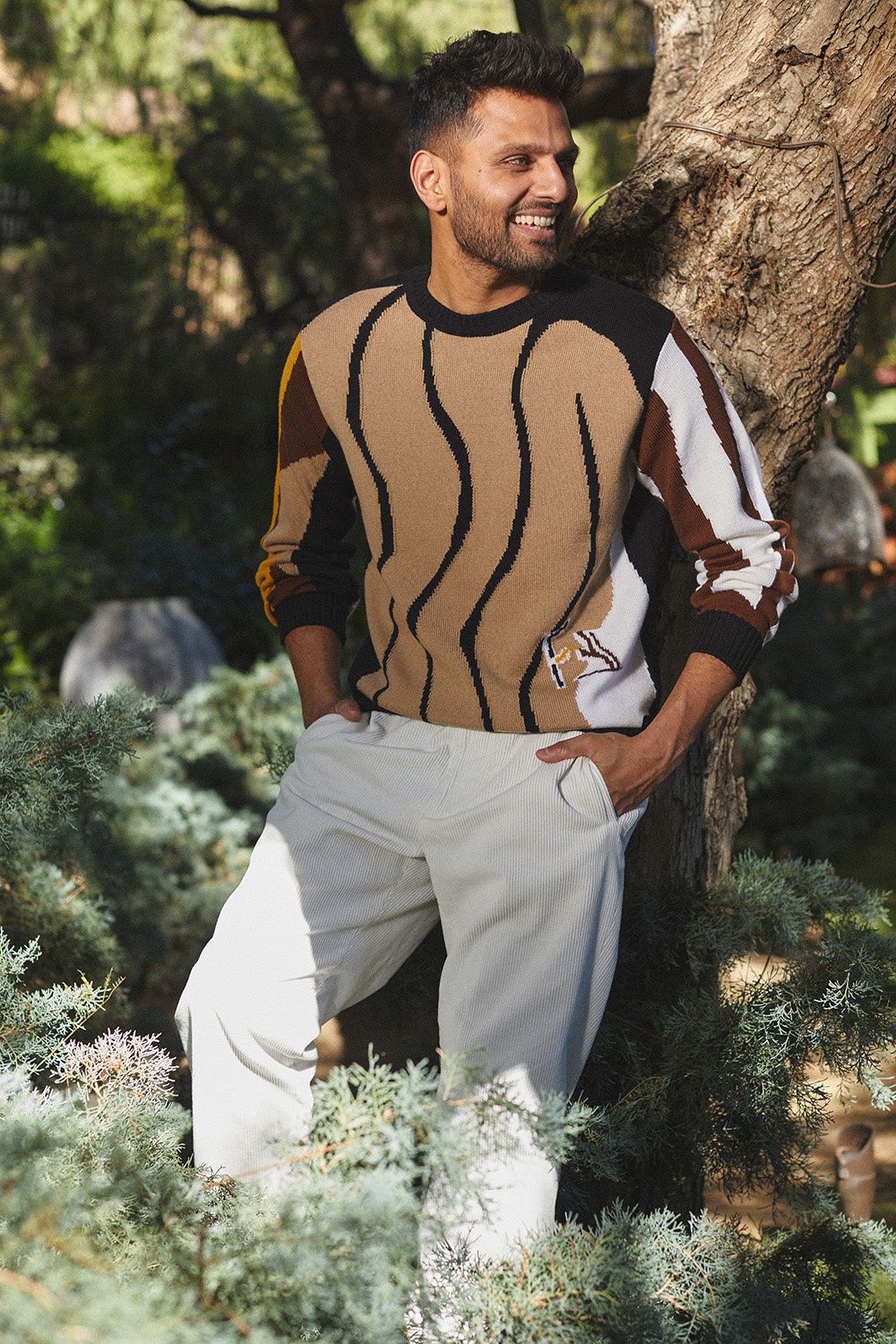
Image: Michael Schwartz, Styling: Mark Holmes.
In the ashram, Jay Shetty was nobody to no one, except other monks. Now you’re an inspiration to millions. How does a former monk deal with fame and power?
As a monk, you’re trained to believe that the most admirable quality in a human being is humility. So, when you get fame, the natural feelings are of arrogance, ego, bravado. I learned early on not to buy into your own hype and not to forget why you have the qualities that people notice in you. A skill we learned as monks is that when you receive a compliment, you thank the person who taught you what is being complimented. So, if you said to me, “Jay, you’re such a great speaker”, my monk training would suggest that I should think of my teacher that trained me in public speaking and pass that gratitude onto them. That way, instead of fuelling your ego, you’re converting a compliment into gratitude.
The other thing is, I’m always small compared to my goals, which means I have work to do.
But it’s an ongoing process. Your ego will appear every day when you wake up. And that’s not going to change for anyone. The difference is how quickly you spot it. That’s the only difference. So before maybe it would’ve taken me months to notice my ego. Now, it’s like I see it as soon as I wake up and I’m like, “There it is again”. You see all of this as the play of the monkey mind. If you had a little monkey in your room, you wouldn’t be mad at it. You’d just be like, “Oh, there’s that silly monkey again”. So, when you see your ego, you don’t stress about it. You just go, “There it is. All right. We’ll deal with that monkey. We’ll figure it out”.

In the world we live in there’s often an inclination to look for contradictions between a successful person’s message and their lifestyle. What is your attitude to contradictions?
That’s why I wrote a book called Think Like A Monk, not Live Like A Monk. Because I’m encouraging people to change their mindset and how they approach things, not change how they live. I think if we all looked at ourselves, we’re all much more layered and complex than just being one thing or the other. If someone said to me, “Jay, do you love marketing?” I’d say, “Yeah, it’s fascinating”. If someone said, “Jay, do you love monk’s wisdom?” Like, “I adore it. It’s the core of how I live”. I’m just trying to be really honest, open, expressive and authentic to what is important to me.
I think we have a limited capacity to see how two opposite things can actually work together. But more often than not, that’s how magic is made. I don’t want to have to choose to be any one thing. And I feel more joyful and happy today than ever before because I’m not suppressing any part of me. That allows me to think like a monk, but live like me.
Do you think the fact you actually lived in the ashram for three years has given you a certain degree of authenticity or street cred? Is that what has resonated with people?
First of all, when I chose to live as a monk, I thought I’d do it forever. I didn’t think I’d ever tell the story. Second of all, I never thought I’d write a book about it. I mean, who would’ve read it? So that wasn’t even the mindset of it.
If it resonates with people, it’s because it’s me mining timeless truths. What I’m sharing with everyone is not an ideology that I invented two years ago. These ideas have been around for thousands of years. And I think it resonates with people because I have genuinely tried to live and apply them in modern life. I think people can see that I’m genuinely grappling with these ideas and I’m okay with not having perfected them. I haven’t solved life. I’m not perfect. I haven’t figured it all out.
One of the biggest take-aways from your book is the importance of service. What advice would you give someone who likes the idea but is struggling to take that first step?
Reach out to someone in your personal or professional life and just say, “Hey, is there anything I can help you with? Are you moving home? Are you struggling to find the next move in your career?” Anything in which you have a skillset or a passion, see how you can use that to help someone else. Service doesn’t mean you need to go and help at your local charity, which is wonderful. You can do that. But service really means, “How can I use the skills and gifts that I have to help someone else who may not have those skills, gifts and privileges?” And that can be applied on a daily basis. You may help a young niece or nephew get their first big break in their career. You may help someone move house. It can be the smallest thing but always try to see how you can help someone who doesn’t benefit you. That’s the key. You’re helping them just because you want to help. And I promise everyone that if they do that, your confidence will grow, your self-esteem will grow, because you’ll see how useful you can be to someone else’s life.
“I’m happy today because i’m not suppressing any part of me.”
Build Monk Muscle
Shetty trains with Eric Strangis, COO of Slay Gym in Hollywood. At present he’s in an “accumulation phase”, aiming to increase volume to boost lean muscle, while torching fat. Use this workout to achieve a full-body awakening.

1a/ Barbell back squat (3×6)
1b/ Barbell reverse lunge (3×12 on each leg)
1c/ Bodyweight split squat (3×20 on each leg)

2a/ DB bench press (3×6)
2b/ Barbell 30° incline bench press (3×12)
2c/ DB chest fly (3×20)

3a/ Weighted ISO crunch (3x20seconds)
3b/ Weighted crunch (3×20)
Rest 10 seconds between exercises and 2 mins between sets.
















